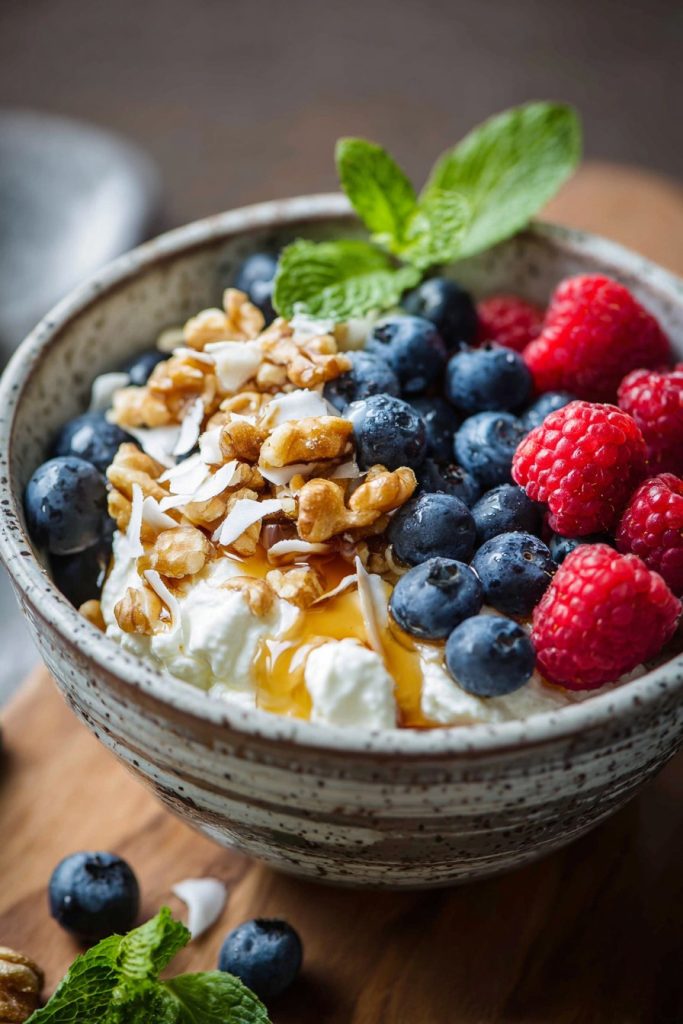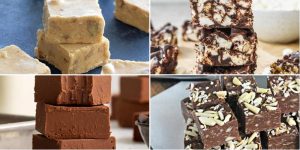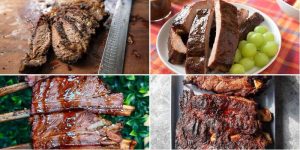Culinary innovation meets morning nutrition in this sophisticated cottage cheese breakfast bowl that transforms humble ingredients into a restaurant-worthy presentation. Contemporary breakfast enthusiasts seeking protein-rich alternatives to traditional morning fare will appreciate the meticulous layering technique and balanced flavor profile achieved through precise ingredient selection and thoughtful assembly methodology.
Why This Recipe Works
- The high-protein foundation of full-fat cottage cheese provides sustained energy release while creating a creamy, substantial base that supports layered toppings without becoming watery or unstable during assembly and consumption.
- Strategic toasting methodology applied to both walnuts and coconut flakes develops complex Maillard reaction compounds that enhance nutty aromatics and provide contrasting textural elements against the creamy dairy component.
- Precise honey distribution through controlled drizzling technique ensures optimal sweetness integration without overwhelming the savory notes, while the viscosity of raw honey creates attractive visual striations across the bowl’s surface.
- Temperature contrast between chilled cottage cheese and room-temperature fruits creates dynamic mouthfeel, with the cold dairy component highlighting the natural sweetness and acidity of seasonal berries.
- Layered assembly protocol ensures structural integrity throughout consumption, preventing ingredient saturation and maintaining distinct textural identities from first bite to last.
Ingredients
- 2 cups full-fat cottage cheese, drained of excess liquid
- 1 cup fresh blueberries, washed and patted dry
- 1 cup fresh raspberries, carefully inspected for quality
- 1/2 cup raw walnuts, roughly chopped to 1/4-inch pieces
- 1/4 cup unsweetened coconut flakes, separated for toasting
- 3 tablespoons raw honey, preferably local and unfiltered
- 1 teaspoon pure vanilla extract, high-quality bourbon variety
- 1/4 teaspoon fine sea salt, for seasoning balance
- Fresh mint leaves for garnish, approximately 8-10 whole leaves
Equipment Needed
- Medium non-stick skillet
- Small baking sheet
- Mixing bowls (various sizes)
- Measuring cups and spoons
- Chef’s knife and cutting board
- Rubber spatula
- Strainer or cheesecloth
- Parchment paper
- Kitchen timer
Instructions

Prepare and Toast Nut Components
Begin by preheating your oven to 325°F and positioning a rack in the center position. Spread the roughly chopped walnuts in a single layer on a parchment-lined baking sheet, ensuring pieces are separated to promote even heat distribution. Toast for 8-10 minutes, rotating the sheet halfway through the cooking time, until the walnuts develop a deep golden-brown color and release a nutty aroma. Simultaneously, heat a medium non-stick skillet over medium-low heat and add the coconut flakes, stirring constantly with a wooden spoon for 3-4 minutes until they achieve a light golden hue and crisp texture. Remove both components immediately from their heat sources to prevent carryover cooking, transferring to separate cooling racks. The toasting process develops essential oil compounds that enhance flavor complexity while creating textural contrast against the creamy cottage cheese base.
Drain and Season Cottage Cheese Base
Place the cottage cheese in a fine-mesh strainer set over a bowl and allow it to drain for 15 minutes at room temperature, gently pressing with a rubber spatula to remove excess whey without compacting the curds. Transfer the drained cottage cheese to a medium mixing bowl and incorporate the vanilla extract and fine sea salt using a folding motion with the spatula, taking care to maintain the curd structure while ensuring even seasoning distribution. The draining process is critical for achieving optimal texture, as excess moisture would compromise the structural integrity of the final assembly and dilute the flavor profile. Allow the seasoned cottage cheese to rest for 5 minutes to enable flavor integration before proceeding to the assembly phase.
Wash and Prepare Fresh Fruit Elements
Carefully sort through the blueberries and raspberries, discarding any damaged or overripe specimens that could introduce unwanted moisture or compromise visual appeal. Gently rinse the selected berries under cold running water in a colander, then transfer to a clean kitchen towel and pat dry with a dabbing motion to remove surface moisture without crushing the delicate fruit structures. This moisture removal step is essential for preventing berry juice from bleeding into the cottage cheese base and creating an unappealing pink discoloration. Arrange the prepared berries in separate small bowls for efficient assembly workflow, ensuring they remain at cool room temperature to maintain optimal texture and flavor expression.
Execute Layered Assembly Technique
Divide the seasoned cottage cheese equally between two serving bowls, using the back of a spoon to create a smooth, slightly concave surface that will cradle the subsequent layers. Arrange the blueberries in a concentric circle around the perimeter of the cottage cheese, followed by a inner ring of raspberries, creating defined color zones that enhance visual appeal. Sprinkle the toasted walnuts evenly across the fruit layers, ensuring distribution reaches all quadrants of the bowl for consistent textural experience. Complete the assembly by scattering the toasted coconut flakes across the surface, concentrating them toward the center to create visual height and textural interest. The strategic layering ensures each component maintains its individual identity while contributing to the overall harmony of the dish.
Final Garnish and Honey Application
Using a honey dipper or small spoon, drizzle the raw honey in a zigzag pattern across the assembled bowls, applying approximately 1.5 tablespoons per serving. The honey should be distributed in thin streams rather than pooled areas to ensure even sweetness distribution without overwhelming individual components. Garnish each bowl with 4-5 fresh mint leaves placed strategically around the perimeter, selecting intact leaves with vibrant color and minimal bruising. Serve immediately to preserve the temperature contrast between the chilled cottage cheese and room-temperature toppings, as this thermal differential significantly enhances the eating experience by highlighting the individual characteristics of each component.
Tips and Tricks
For optimal texture management, consider pressing the cottage cheese between layers of paper towels after the initial draining process to extract additional moisture, particularly if using store-bought varieties that often contain higher water content than artisanal versions. This extra step can be accomplished by placing the drained cottage cheese in a clean kitchen towel and gently twisting to apply controlled pressure, being careful not to over-compress the curds into a paste-like consistency. When selecting cottage cheese, prioritize brands with larger curd size and creamier dressing, as these typically provide superior mouthfeel and structural integrity compared to fine-curd varieties. For enhanced flavor development, consider toasting the walnuts in a single layer on the middle oven rack rather than using stovetop methods, as the dry heat environment promotes more even browning and deeper flavor extraction from the nut oils. If working in a humid environment, store the toasted coconut flakes in an airtight container immediately after cooling to prevent moisture absorption that would compromise their delicate crispness. For advanced presentation techniques, utilize ring molds to create perfectly cylindrical cottage cheese bases, then carefully remove the mold before adding fruit layers to achieve restaurant-quality vertical presentation. When working with particularly juicy berries, a light dusting of finely ground almond flour between the cottage cheese and fruit layers can create a moisture barrier that prevents sogginess while adding subtle nutty undertones. For temperature optimization, chill your serving bowls in the refrigerator for 15-20 minutes before assembly to maintain the cool foundation that contrasts beautifully with room-temperature toppings. If preparing components in advance, store toasted nuts and coconut separately from other elements and combine just before serving to preserve textural integrity throughout the eating experience.
Recipe Variations
- Mediterranean-Inspired Version: Substitute the berries with 1 cup diced cucumber, 1/2 cup cherry tomatoes halved, 1/4 cup chopped Kalamata olives, and 2 tablespoons chopped fresh dill. Replace honey with a drizzle of extra virgin olive oil and a squeeze of fresh lemon juice, garnishing with crumbled feta cheese and freshly cracked black pepper for a savory breakfast alternative.
- Tropical Paradise Variation: Use 1 cup diced fresh pineapple, 1/2 cup sliced mango, and 1/4 cup toasted macadamia nuts instead of the berries and walnuts. Substitute the vanilla extract with 1/2 teaspoon coconut extract and replace the honey with agave nectar, garnishing with toasted coconut chips and fresh lime zest for bright acidity.
- Autumnal Harvest Bowl: Replace berries with 1 cup roasted cubed sweet potato (cooled), 1/2 cup sautéed apples with cinnamon, and 1/4 cup toasted pecans. Incorporate 1 teaspoon maple extract instead of vanilla and use pure maple syrup instead of honey, finishing with a sprinkle of pumpkin pie spice for seasonal warmth.
- Protein-Powered Athlete’s Version: Add 1 scoop of unflavored collagen peptides or vanilla protein powder to the cottage cheese during seasoning, along with 2 tablespoons chia seeds and 1 tablespoon flax seeds. Include 1/2 cup sliced banana for natural sweetness and complex carbohydrates, maintaining the honey drizzle for quick energy availability.
Frequently Asked Questions
Can I make cottage cheese breakfast bowls ahead of time for meal prep?
While component preparation can be completed in advance, full assembly should occur immediately before serving to maintain optimal texture integrity. The cottage cheese base can be seasoned and stored in an airtight container in the refrigerator for up to 2 days, while toasted nuts and coconut should be kept separately at room temperature in sealed containers. Fruits should be washed and dried no more than 12 hours before assembly to prevent deterioration. When ready to serve, combine all elements quickly to preserve the contrasting textures that define this dish’s culinary appeal. The exception would be savory variations containing vegetables, which can often withstand longer storage without significant quality compromise.
What’s the best method for draining cottage cheese effectively?
For optimal moisture removal, employ a two-stage draining process beginning with a fine-mesh strainer over a bowl for 15 minutes at room temperature, followed by a gentle pressing between layers of cheesecloth or paper towels. The initial draining removes excess whey through gravity, while the secondary pressing extracts additional moisture without crushing the delicate curd structure. For particularly watery commercial brands, consider lining the strainer with coffee filters, which provide superior liquid absorption compared to standard kitchen strainers. The goal is to achieve a creamy yet firm consistency that supports toppings without becoming watery, typically reducing volume by approximately 15-20% through the complete draining process.
Are there suitable cottage cheese substitutes for lactose-intolerant individuals?
Several alternatives provide similar texture and functional properties while accommodating dietary restrictions. Full-fat Greek yogurt offers comparable protein content and creamy texture, though it may require additional straining to achieve the desired thickness. For dairy-free options, firm tofu crumbled and mixed with a tablespoon of nutritional yeast provides surprising similarity in appearance and mouthfeel, while soaked and blended cashews create a rich, neutral base. Regardless of substitution, maintain the seasoning protocol with vanilla and salt to replicate the flavor profile, and adjust liquid components accordingly since alternative bases may have different moisture content than traditional cottage cheese.
How can I prevent the berries from making the cottage cheese watery?
Moisture management begins with proper berry preparation—thorough drying after washing is essential. Additionally, creating a strategic barrier layer between the cottage cheese and berries significantly reduces liquid transfer. A light sprinkling of ground nuts, toasted oat flour, or even a thin layer of the coconut flakes placed directly on the cottage cheese before adding berries creates effective separation. Serving temperature differential also plays a crucial role; thoroughly chilled cottage cheese (38-40°F) combined with room-temperature berries minimizes condensation and juice release. Finally, assembly timing is critical—complete the final construction no more than 5 minutes before serving to maintain textural integrity throughout the eating experience.
Summary
This chef-crafted cottage cheese breakfast bowl elevates morning nutrition through precise technique and balanced flavor architecture. The method emphasizes texture contrast, temperature management, and visual presentation while delivering substantial protein content and customizable variations to suit diverse culinary preferences.
Elevated Cottage Cheese Breakfast Bowl
4
servings25
minutes10
minutesIngredients
Instructions
- 1 Toast walnuts at 325°F for 8-10 minutes and coconut flakes in skillet for 3-4 minutes until golden
- 2 Drain cottage cheese 15 minutes, then mix with vanilla and salt
- 3 Wash and thoroughly dry berries
- 4 Layer cottage cheese, berries, nuts, and coconut in bowls
- 5 Drizzle with honey and garnish with mint before serving



